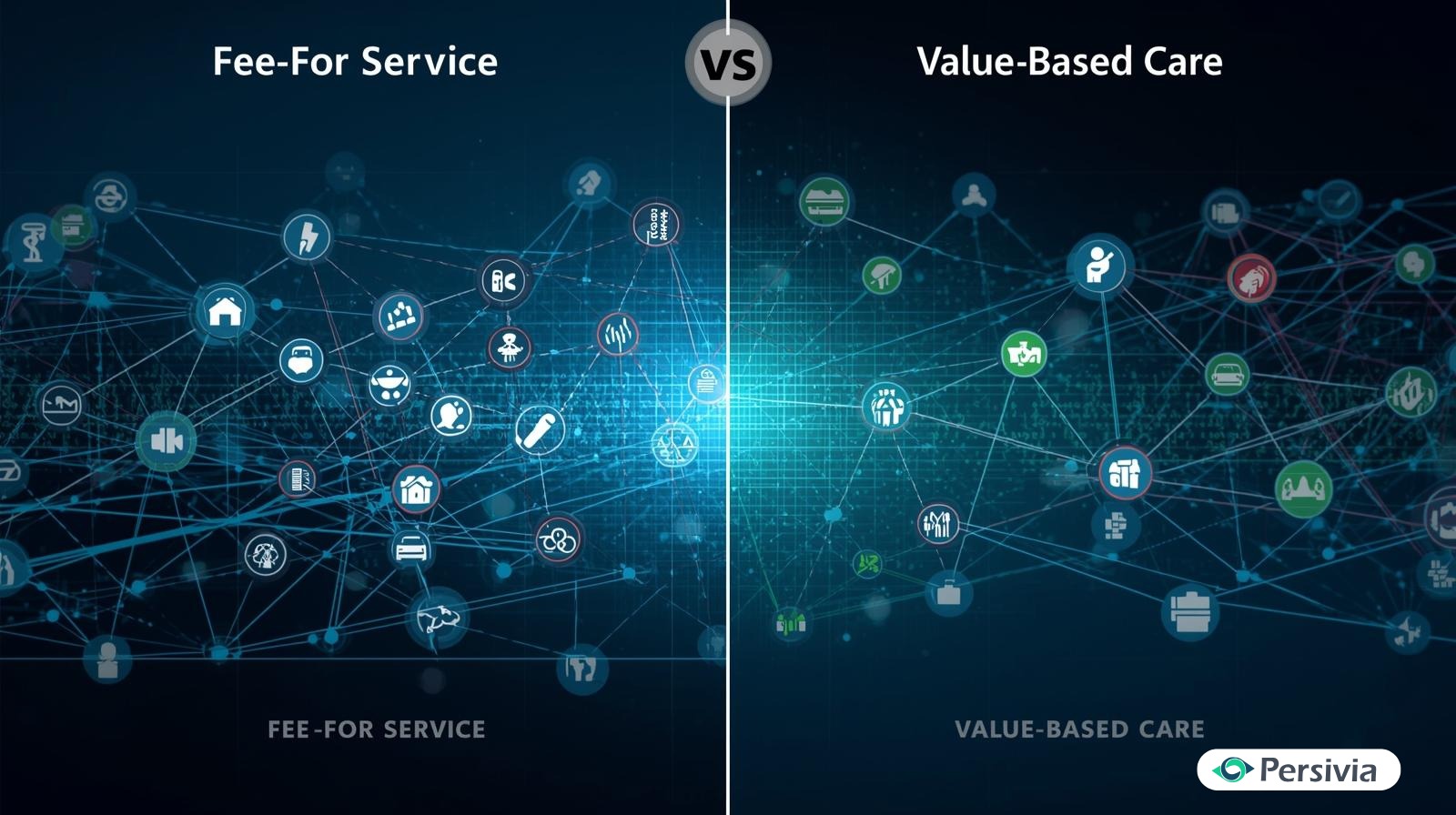Fee for Service vs Value-Based Care: Which Model Sustains Healthcare Long-Term?
The models of healthcare payments influence the modes of care delivery by providers. Fee-for-Service is a model where providers are paid for each service delivered, which can sometimes lead to unnecessary procedures. Value-based care incentivizes patient health and outcomes, promoting coordination and prevention. Whereas the FFS maximizes revenue, the VBC minimizes costs and enhances quality. The long-term sustainability of the healthcare industry is moving toward value-based models, and hybrid models combining both are increasingly common.
Healthcare operates on money, and the flow of money dictates all things, such as your wait time to your level of treatment. Fee for Service vs Value-based Care is not just a billing argument; it is an argument on whether healthcare is based on quantity or quality. One of the models rewards doctors to do more. The other rewards them for doing better.
American healthcare has long operated under the Fee-for-Service model. Physicians are charged for each test, procedure, and visit. An increased number of services increased revenue. However, this resulted in a system whereby doing more and helping more may not necessarily be the same thing. Value-based care reversed the game. It does not reward volume, but rewards results. When patients are healthy, the providers get more profit rather than when they come back with complications. It is not only the shift of payment structures, but it is also changing the way healthcare functions.
What is Fee for Service?
Fee-for-service is a type of payment whereby medical care providers are paid per service they offer. Each consultation, test, procedure, and treatment is billed individually.
This traditional approach creates straightforward incentives. Providers earn more by delivering more services. A doctor who orders ten tests makes more than one who orders five, regardless of whether all ten were necessary.
How Fee-For-Service Works
The process follows a simple cycle:
- Patient visits the provider
- Provider delivers service (exam, test, procedure)
- Provider bills insurance or the patient
- Payment processes based on service codes
- Revenue increases with service volume
Common Fee for Service Examples
Medical practices use this model across specialties:
- Primary care visits are billed per appointment
- Lab tests are charged individually
- Surgical procedures priced by complexity
- Imaging scans are billed separately
- Specialist consultations are charged per visit
What is Value-Based Care?
Value-based care pays the providers according to the patient’s health outcome instead of the amount of services. Providers are rewarded for maintaining patients’ health and the management of chronic ailments.
This modern model is characterized by less emphasis on the treatment of illness and more on prevention. Healthcare teams are coordinating patient follow-up and interventions focused on enhancing long-term health.
Core Principles of Value-Based Care
Value-based care vs fee-for-service differs fundamentally in approach:
- Patient outcomes drive reimbursement
- Preventive care receives priority
- Care coordination across providers
- Quality metrics determine payments
- Population health management matters
Value-Based Care Payment Models
| Model Type | How It Works | Provider Risk |
| Shared Savings | Providers share cost savings achieved | Low |
| Bundled Payments | A single payment covers an episode of care | Medium |
| Capitation | Fixed amount per patient per month | High |
| ACOs | Groups share accountability for populations | Medium-High |
Key Differences Between Fee-for-Service and Value-Based Care
Healthcare payment models create different worlds for patients and providers. The structure of payment determines how care gets delivered.
Payment Structure
Fee for Service pays per transaction. Every service generates a bill. Value-based care pays for results. Better outcomes mean better reimbursement. One counts services. The other counts success.
Care Focus and Priorities
The incentives shape everything:
Fee for Service encourages:
- High service volume
- Reactive treatment
- Individual procedures
- Specialist referrals
- Repeat visits
Value-based care promotes:
- Health maintenance
- Preventive interventions
- Coordinated teams
- Primary care emphasis
- Continuous monitoring
Patient Satisfaction Impact
Patient experience diverges drastically between models. Fee for Service often neglects satisfaction since reimbursement is tied to services delivered. Value-based care puts high importance on patient satisfaction since the results and satisfaction of patients correlate with the reimbursement rates.
The Superiority of Value-Based Care
The contemporary healthcare environment requires efficiency, quality, and accessibility. Value-based care meets all three borders that the conventional models fail in.
Incentivizing Preventive Care
VBC aims to support patient health by means of early intervention. The method will promote routine screenings, lifestyle education, and care of chronic diseases. Early detection of issues will help the providers to minimize expensive treatment and emergency management in the future.
It is cheaper to prevent than to cure. A diabetes prevention program might cost thousands. The expensive treatment of the complications of diabetes is in the hundreds of thousands. Prevention is the math of value-based care.
Enhanced Collaboration and Coordination
The most significant differences in terms of teamwork arise between value-based care vs fee-for-service. VBC promotes the cooperation between various providers and specialties. This creates cohesive, coordinated approaches to patient care.
Care teams share information through integrated systems. The playbook is followed by primary doctors, specialists, nurses, and pharmacists. Healthcare quality reports indicate that coordinated care lowers hospital readmission rates by 25% to fragmented strategies.
Promoting Health Equity
Value-based care also helps in equity of health care in that the provider is rewarded to deliver desirable results, irrespective of whether the patient is able to pay or not. This makes sure that every patient is accorded the best care according to need and not the wallet size.
The model deals with social determinants of health. Providers receive incentives for helping patients with transportation, housing services, and nutrition programs. Health becomes about more than medicine.
Cost Savings for Patients and Systems
The incentivization of the positive results enhances patient well-being and achieves huge savings in costs. Value-based care helps to minimize the unnecessary treatments and hospitalizations that consume resources without enhancing health.
The savings compound:
- Fewer emergency room visits
- Reduced hospital readmissions
- Lower specialist referral rates
- Decreased duplicate testing
- Minimized medication errors
Long-Term Healthcare Quality Improvement
The adoption of value-based systems is popular among experts. This is in line with the general objectives of enhancing affordability and quality of healthcare in the long term. The model develops sustainable economics of healthcare and enhances population health.
Challenges of Fee-for-Service
The old form of payment structure has unintended effects, leading to poor quality and affordability of healthcare.
Overutilization of Services
Fee-for-service is likely to increase costs due to overuse. In a situation where revenue relies on the number of performed services, the providers are under pressure to order additional tests and procedures. This drives excessive interventions that don’t always benefit patients.
Defensive medicine compounds the problem. Doctors order unnecessary tests to protect against liability rather than improve diagnosis.
Limited Focus on Outcomes
The model compensates providers regardless of results. A surgeon gets paid whether the patient recovers fully or suffers complications. This disconnects payment from performance.
Rising Healthcare Costs
Fee for Service drives continuous cost increases. More services mean higher bills. The system rewards doing more, never doing less. Healthcare spending grows faster than inflation year after year under this model.
Patient Experience Gaps
Patients find themselves in a disjointed care where there is no one to coordinate them through the process. Various experts are operating individually. Communication breaks down. Patients retell their history each time they see the doctor.
Advantages of Value-Based Care
Modern payment models address traditional healthcare’s biggest problems while creating better experiences for everyone involved.
Better Patient Outcomes
Value-based care links payment to results. Providers succeed when patients get healthier. This alignment creates powerful incentives for evidence-based medicine and outcome tracking.
Chronic disease management improves dramatically. Diabetic patients receive regular monitoring. Visits to the home are provided to heart failure patients. The cancer survivors receive follow-ups, which are coordinated.
Reduced Healthcare Spending
Preventive cost reduction is effective. Value-based care checks senseless treatments and hospitalization. The resources are redirected to interventions that enhance health in fact.
The model rewards efficiency:
- Generic medications over brand names when appropriate
- Outpatient procedures instead of hospital admissions
- Telehealth visits are replacing in-person appointments
- Community health workers supporting high-risk patients
Improved Care Coordination
An electronic health system facilitates the flow of information between care teams. Practitioners can have access to full patient histories, medication lists, and test results in real-time. This coordination aids in the elimination of dangerous gaps and duplications.
Focus on Prevention
Prevention is profitable with the use of value-based care. Wellness programs, screenings, and health education are invested in by the providers. Efforts to keep people healthy yield more returns than taking them to the hospital when they are ill.
Choosing the Right Healthcare Model
The decision made on the payment models depends on organizational objectives, patient groups, and regulatory demands.
Factors to Consider
Several elements influence model selection:
- Financial stability and risk tolerance
- Patient demographics and health status
- Technology infrastructure capabilities
- Provider network readiness
- Payer contract opportunities
Fee for Service Benefits
Some situations favor traditional payment:
- Specialized surgical practices
- High-acuity procedural services
- Fee-for-service empowers patient choices in provider selection
- Straightforward revenue tracking
- Minimal administrative burden
Value-Based Care Advantages
Other scenarios benefit from outcome-based payment:
- Primary care practices
- Chronic disease management programs
- Large integrated health systems
- Population health initiatives
- Long-term sustainability goals
Final Call
The healthcare sector is at a vanguard point: volume is being rewarded by fee-for-service, and value-based care is rewarded by outcomes. The former (FFS) ensures predictable income but often raises costs without improving health. However, value-based care reduces costs, improves outcomes, and promotes equity, which makes it more sustainable.
Persivia supports the performance of healthcare organizations in value-based care through the CareSpace® platform. It combines population health management, care coordination, and real-time analytics to provide actionable insights, workflow streamlining, and enhanced quality and cost performance.






